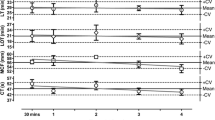Summary
Intravascular activation of the coagulation system produces disseminated intravascular coagulation or deep vein thrombosis and is characterized by the occurrence of circulating soluble fibrin monomer complexes (FM) in plasma. In order to evaluate the prognostic and diagnostic value of this parameter in 156 patients with fractures of the femur, neck of the femur, tibia, and fibula, and with knee-joint or elective hip surgery, soluble fibrin monomer complexes (FM) were determined using the FM Test from Boehringer Mannheim/Diagnostica STAGO (erythrocyte agglutination test according to Largo). Plasma samples were taken prior to and on the 1st, 2nd, 3rd, 5th, 7th, and 9th postoperative day. Diagnosis of DVT was carried out by 125-I-labelled fibrinogen test in parallel. Positive results were checked by phlebography on the 7th or 9th postoperative day. Positive FM results were obtained in only 26% of patients without DVT. In 34 of 36 patients (94%) with postoperative DVT confirmed by phlebography, on the other hand, elevated FM levels were detected 2–4 days before the 125-I-labelled fibrinogen test gave positive results. The predictive value calculated on the basis of elevated FM levels is 63–73%. These results show that the FM Test allows early detection of a prethrombotic state in the development of postoperative DVT.
Similar content being viewed by others
Abbreviations
- FM:
-
fibrinmonomer
- s.c.:
-
subcutaneous
- aPTT:
-
activated partial thromboplastin time
- TT:
-
thrombin time
- % RTA:
-
residual thrombin activity
- SFMC:
-
soluble fibrin monomer complexes
- DVT:
-
deep vein thrombosis
- AT III:
-
antithrombin III
References
Brockhaus W, Bruhn HD, Schlebusch H, Schöndorf TH, Tilsner V (1982) Erprobung einer chromogenen Bestimmungsmethode für low-dose-Heparin. Unveröffentlichte Ergebnisse
Contant G, Gouault-Heilmann M, Martinoli JL (1983) Heparin inactivation during blood storage: its prevention by blood collection in citric acid, theophylline, adenosine, dipyramidole-CTAD-mixture. Thromb Res 31:365–374
Kakkar VV (1989) Fixed combinations of low-molecular weight or unfractionated heparin plus dihydroergotamine in the prevention of postoperative deep vein thrombosis. Am JSurg 157:413–418
Ku\mann J (1986) Probleme der Thromboembolieprophylaxe mit niedrig dosierten Heparin. Langenbecks Arch Chir 369:473–478 (Kongre\-bericht 1986)
Ku\mann J, Boehnke J, Kückelhaus HG, Herbold U (1988) Erfahrungen mit der Thromboseprophylaxe unter Verwendung von nicht fraktioniertem Heparin bei Patienten mit Frakturen des koxalen Femurendes. In: Weber U, Schöndorf TH (Hrsg) Thrombose und Embolie. Thieme, Stuttgart New York
Ku\mann J (1988) Probenaufbereitung zur Heparinbestimmung mit einem thrombocytenprotektiven Cocktail. Lab Med 12:244–245
Largo R, Heller V, Straub P (1976) Detection of soluble intermediates of the fibrinogen-fibrin-conversion using erythrocytes coated with fibrin monomers. Blood 47:991–1002
Leyvraz P (1983) Adjusted versus fixed-dose subcutaneous heparin in the prevention of deep vein thrombosis after total hip replacement. N Engl J Med 309:954–958
Lill H, Röschlau P, Witt I (1983) Photometrischer Kontroll-test für die Low Dose-Heparintherapie. In: van de Loo J, Asbeck F (Hrsg) HÄmostase, Thrombophilie und Arteriosklerose, Berichtsband 2. Kongre\ für Thrombose und HÄmostase Münster 1982, Schattauer, Stuttgart, S 238
Oehler G, Klaus H, Stötzer KE, Spanuth E (1987) Der Nachweis von löslichen Fibrinmonomer-Komplexen. Methodenvergleich eines Erythrozyten-Agglutinationstests nach Largo (FM-Test) mit dem Ethanol-Gelierungs-Test. Lab Med 11:25–30
Planes A (1988) Prevention of postoperative venous thrombosis: a randomized trial comparing unfractionated heparin with low molecular heparin in patients undergoing total hip replacement. Thromb Haemost 60:407–410
Schöndorf TH (1981) Wertigkeit und Grenzen der Low-dose-Heparin-Prophylaxe zur Verhütung postoperativer thromboembolischer Komplikationen. Haemostaseologie 1:143–150
Schöndorf T, Paplham H, Franz K (1983) Determination of heparin partial thromboplastin time and antithrombin III after subcutaneous heparin administration. In: Witt I (ed) Heparin. New biochemical and medical aspects. deGruyter, Berlin New York, pp 315–327
The European Fraxiparin Study (EFS) Group (1988) Comparison of a low molecular weight heparin and unfractionated heparin for the prevention of deep vein thrombosis in patients undergoing abdominal surgery. Br J Surg 75:1058–1063
Author information
Authors and Affiliations
Rights and permissions
About this article
Cite this article
Vogel, G., Spanuth, E. Predictive value of fibrin monomers in postoperative deep vein thrombosis. Klin Wochenschr 68, 1020–1026 (1990). https://doi.org/10.1007/BF01646548
Received:
Revised:
Accepted:
Issue Date:
DOI: https://doi.org/10.1007/BF01646548




